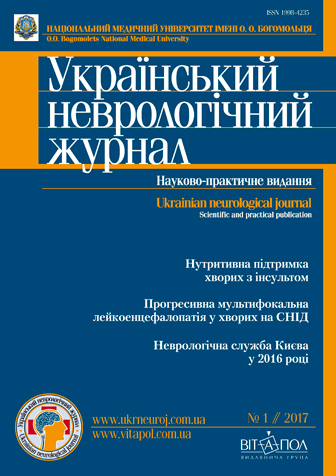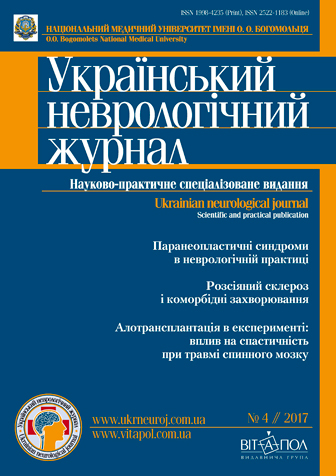- Issues
- About the Journal
- News
- Cooperation
- Contact Info
Issue. Articles
¹1(42) // 2017

1. Reviews
|
Notice: Undefined index: picture in /home/vitapol/ukrneuroj.vitapol.com.ua/en/svizhij_nomer.php on line 74 Notice: Undefined index: pict in /home/vitapol/ukrneuroj.vitapol.com.ua/en/svizhij_nomer.php on line 75 Nutritional support for patients with stroke: current interdisciplinary approach and clinical practice of Stroke Center, Clinic OberigYu. V. FlominMC «Universal Clinic Oberig», Kyiv |
|---|
Keywords: stroke, dysphagia, malnutrition, post-stroke rehabilitation, complications, outcome.
Notice: Undefined variable: lang_long in /home/vitapol/ukrneuroj.vitapol.com.ua/en/svizhij_nomer.php on line 188
2. Reviews
|
Notice: Undefined index: picture in /home/vitapol/ukrneuroj.vitapol.com.ua/en/svizhij_nomer.php on line 74 Notice: Undefined index: pict in /home/vitapol/ukrneuroj.vitapol.com.ua/en/svizhij_nomer.php on line 75 Clinical and experimental background of viral infection impact on ischemic stroke development and consequencesN. S. TurchynaO. O. Bogomolets National Medical University, Kyiv |
|---|
Keywords: viral infection, atherosclerosis, acute cerebral blood circulation impariment.
Notice: Undefined variable: lang_long in /home/vitapol/ukrneuroj.vitapol.com.ua/en/svizhij_nomer.php on line 188
3. Reviews
|
Notice: Undefined index: picture in /home/vitapol/ukrneuroj.vitapol.com.ua/en/svizhij_nomer.php on line 74 Notice: Undefined index: pict in /home/vitapol/ukrneuroj.vitapol.com.ua/en/svizhij_nomer.php on line 75 A modern approach to poststroke cognitive impairmentG. R. TereshchenkoOleksandrivska Clinical Hospital, Kyiv |
|---|
Keywords: stroke, cognitive impairment, dementia, depression.
Notice: Undefined variable: lang_long in /home/vitapol/ukrneuroj.vitapol.com.ua/en/svizhij_nomer.php on line 188
4. Original researches
|
Notice: Undefined index: picture in /home/vitapol/ukrneuroj.vitapol.com.ua/en/svizhij_nomer.php on line 74 Notice: Undefined index: pict in /home/vitapol/ukrneuroj.vitapol.com.ua/en/svizhij_nomer.php on line 75 Status of the cerebral hemodynamics in the early stages of the atherosclerotic and hypertensive dyscirculatory encephalopathyV. V. Kuznetsov1, S. G. Mazur2, O. G. Skripchenko11 SI «D. F. Chebotarev Institute of Gerontology of NAMS of Ukraine», Kyiv |
|---|
Methods and subjects. We examined 217 persons aged 40 — 59 years (mean age 51.4 ± 5.9 years). According to the results of a comprehensive examination were identified 140 people with the initial stage of the dyscirculatory encephalopathy, who were separated into 3 groups according to the etiology of the disease (hypertension, atherosclerosis, and their combination). The control group consisted of healthy individuals matched by age, without any signs of cerebral atherosclerosis and high blood pressure. All patients underwent clinical, neurological, instrumental and laboratory examination. The ultrasound duplex scanning by Philips EnVisor (Netherlands) was performed to assess atherosclerotic changes of brachiocephalic vessels.
Results. Patients with an initial hypertensive dyscirculatory encephalopathy demonstrated lowering of linear systolic velocity of cerebral blood flow in the carotid (two CCA) and vertebrobasilar vessels (right VA and BA), the absence of atherosclerotic plaques and stenosis of the brachiocephalic vessels. Patients with an initial atherosclerotic dyscirculatory encephalopathy demonstrated reduced linear systolic velocity of cerebral blood flow in the vertebrobasilar (2 VA, PCA, BA) and some of the carotid vessels (left ICA, right MCA). Patients with combined dyscirculatory encephalopathy initial stage suffered from reduced linear systolic velocity of cerebral blood flow in the vertebrobasilar (2 VA, BA) and carotid (2 internal carotid and middle cerebral artery) vessels. In 63.8 % of patients with an initial atherosclerotic DE we diagnosed different structure plaques, with prevalence of heterogeneous type — 59.5 %. In the group of patients with an initial combined DE, 84.6 % of patients had the presence of atherosclerotic plaques, of which 68.3 % of a heterogeneous structure.
Conclusions. Comparative analysis of the cerebral blood flow for patients with initial stages of hypertensive, atherosclerotic, and combine dyscirculatory encephalopathy shows that patients with initial atherosclerotic dyscirculatory encephalopathy have more evident changes of cerebral hemodynamics and structural-morphological changes of brachiocephalic vessels at the early stages than patients with initial hypertensive dyscirculatory encephalopathy.
Keywords: cerebral blood flow, dyscirculatory encephalopathy, initial stages.
Notice: Undefined variable: lang_long in /home/vitapol/ukrneuroj.vitapol.com.ua/en/svizhij_nomer.php on line 188
5. Original researches
|
Notice: Undefined index: picture in /home/vitapol/ukrneuroj.vitapol.com.ua/en/svizhij_nomer.php on line 74 Notice: Undefined index: pict in /home/vitapol/ukrneuroj.vitapol.com.ua/en/svizhij_nomer.php on line 75 The possibility of cognitive dysfunction preventive therapy: cardiac pacemaker for patients with bradyarrythmiaS. M. StadnikMilitary Medical Clinical Centre of the Western Regions, Lviv |
|---|
Methods and subjects. In the clinical study included 47 patients (mean age 72.8 ± 6.2 years), who were separated into 2 therapeutic groups: the 1st group consisted of 32 patients with bradyarrhythmia, who underwent implantation of a permanent electro cardiac stimulation; the 2nd group — 15 patients with bradyarrhythmia, with only medical therapy as a treatment. All patients at the beginning of therapy were performed neuropsychological tests to evaluate cognitive functions. In addition, we determined the state of cognitive functions, depending on the àðîÅ(4+)genotype. Following 1 and 6 months we repeated the examination and assessment of cognitive functions.
Results. Evaluation of the pacing effectiveness according to CGI scale demonstrated that in the studied group of patients positive effect was observed in 68.7 % of patients. Before the expiration of the six-month observation significant improvement (compared to rating before the start of the electro cardiac stimulation) was established for 7 of the 9 rating scales and tests: MMSE, a Battery of frontal dysfunction, Boston naming test, 2 tests from the scale of the Mattis dementia («Memory» and «Sound association»), a test of delayed recall of 10 words and a test of drawing of hours. In addition, it was found that the clinical effect of electro cardiac stimulation was higher in patients having àðîÅ(4+) genotype.
Conclusions. Electro cardiac stimulation has shown its clinical efficacy in relation to cognitive disorders in patients with bradyarrhythmia, including those with genotype in àðîÅ(4+), who are in the group of high risk of Alzheimer’s disease development.
Keywords: cognitive disorder, bradyarrhythmia, preventive therapy, electro cardiac stimulation.
Notice: Undefined variable: lang_long in /home/vitapol/ukrneuroj.vitapol.com.ua/en/svizhij_nomer.php on line 188
6. Original researches
|
Notice: Undefined index: picture in /home/vitapol/ukrneuroj.vitapol.com.ua/en/svizhij_nomer.php on line 74 Notice: Undefined index: pict in /home/vitapol/ukrneuroj.vitapol.com.ua/en/svizhij_nomer.php on line 75 Functional outcomes in patients in early recovery period of ischemic hemispheric stroke depending on serotonin and melatonin blood levelsS. O. MedvedkovaZaporizhzhia State Medical University |
|---|
Methods and subjects. complex clinical and paraclinical investigation was done among 77 patients (the mean age of patients was 57.9 ± 0.9 years) on early recovery period of CHIS with the usage of clinical scales (National Institute of Health Stroke Scale, Barthel Index, modified Rankin Scale) on the 10th, 30th, 90th and 180th day of disease, visualization of cerebral structures by CT scan, identification of serum concentration of melatonin and the level of serotonin on the 10th, 30th day of disease, and also by the coefficient calculation of melatonin-serotonin ratio (MSR) = serum concentration of melatonin/plasma level of serotonin.
Results. on the grounds of comparative ROC-analysis it was defined that the most informative parameters for prediction of incomplete activities of daily living recovery (according to Barthel Index < 100 points) on the 180th day are: the serotonin plasma level on the 30th day (AUC = 0.78, p < 0.05), dynamics of serotonin plasma level on the 30th day (AUC = 0.76, p < 0.05), MSR on the 30th day (AUC = 0.73, p < 0.05), dynamics of MSR on the 30th day (AUC = 0.67, p < 0.05), dynamics of melatonin serum level on the 30th day (AUC = 0.66, p < 0.05) and melatonin serum concentration on the 30th day (AUC = 0.64, p < 0.05).
Conclusions. The serotonin plasma level ≤ 0.2 mcmol/l on the 30th day is the predictive criterion of incomplete activities of daily living recovery as for value according to Barthel Index < 100 points on the 180th day (AUC = 0.78, p < 0.05; sensitivity = 80.0 %, specificity = 75.0 %); the predictors of daily living recovery as for value according to Barthel Index < 100 points on the 180th day are the melatonin serum concentration on the 30th day ≤ 33.02 pg/ml (AUC = 0.64, p < 0.05; sensitivity = 60.0 %, specificity = 76.3 %) and the level of MSR > 183.6 (AUC = 0.73, p < 0.05; sensitivity = 90.0 %, specificity = 62.5 %).
Keywords: cerebral infarction, early recovery period, serotonin, melatonin, prognosis.
Notice: Undefined variable: lang_long in /home/vitapol/ukrneuroj.vitapol.com.ua/en/svizhij_nomer.php on line 188
7. Original researches
|
Notice: Undefined index: picture in /home/vitapol/ukrneuroj.vitapol.com.ua/en/svizhij_nomer.php on line 74 Notice: Undefined index: pict in /home/vitapol/ukrneuroj.vitapol.com.ua/en/svizhij_nomer.php on line 75 Peculiarities of myasthenia gravis, associated with other autoimmune diseasesK. V. Antonenko1, T. I. Illyash1, L. O. Vakulenko2, N. V. Kovalenko2, N. V. Syrota2, T. V. Shoptenko21 O. O. Bogomolets National Medical University, Kyiv |
|---|
Methods and subjects. 42 patients with myasthenia gravis were examined. Clinical examination, tests with physical activity and pharmacological tests with neostigmine, electromyography, spiral computed tomography of the mediastinum, the detection of anti-acetylcholine receptors antibodies, ultrasound and hormone study of thyroid gland, consultation of rheumatologist to exclude connective tissue disorders were carried out. Association of myasthenia gravis with other autoimmune diseases was found in 9 (21.4 %) patients. In these patients thyroid gland pathology prevailed — Grave’s disease (n = 4), autoimmune thyroiditis (n = 2). Rheumatoid arthritis was revealed in 2 patients. In one patient myasthenia gravis associated both with thyroid gland pathology, and rheumatoid arthritis. In 33 patients with myasthenia gravis other autoimmune diseases were not diagnosed.
Results. Comparison of two groups of patients (with myasthenia gravis and myasthenia gravis, associated with other autoimmune diseases) revealed that patients with combination of autoimmune diseases were younger at onset of myasthenia gravis symptoms (34.7 ± 3.4 versus 46.1 ± 5.8 years, p < 0.05). In both groups, generalized myasthenia gravis and moderate muscle weakness prevailed. As a result of the treatment (anticholinergic drugs, steroids, thymectomy, plasmapheresis) the number of patients with mild manifestations of the disease increased, although there were revealed no statistically significant differences between groups.
Conclusions. Patients with myasthenia gravis, associated with other autoimmune disorders were younger at onset of myasthenia gravis symptoms. Patients with myasthenia gravis with/without concomitant autoimmune disease did not differ on the severity of clinical manifestations and consequences of the disease. In all patients with myasthenia gravis, associated with autoimmune thyroid disease, oculomotor muscles were involved in the pathological process.
Keywords: myasthenia gravis, autoimmune diseases, thyroid gland.
Notice: Undefined variable: lang_long in /home/vitapol/ukrneuroj.vitapol.com.ua/en/svizhij_nomer.php on line 188
8. Experimental researches
|
Notice: Undefined index: picture in /home/vitapol/ukrneuroj.vitapol.com.ua/en/svizhij_nomer.php on line 74 Notice: Undefined index: pict in /home/vitapol/ukrneuroj.vitapol.com.ua/en/svizhij_nomer.php on line 75 The effect of Neurogel with neural crest stem cells implantation on motor function recovery after experimental spinal cord injuryV. I. Tsymbaliuk1, V. V. Medvediev2, R. G. Vasiliev3, 4, O. A. Rybachuk3, 4, V. I. Kozyavkin5, N. G. Draguntsova11 SI «Institute of Neurosurgery named after acad. A. P. Romodanov of NAMS of Ukraine», Kyiv |
|---|
Methods and subjects. Animals: outbred albino rats (5.5 months, 250 g); experimental groups: 1 — spinal cord injury only (males; n = 16); 2 — spinal cord injury + immediate homotopical transplantation of Neurogel (males; n = 20); 3 — spinal cord injury + analogous transplantation of Neurogel in association with adult mouse NCSC (n = 12). Group 3 consisted of male (n = 6) and female (n = 6) animals, respectively, — subgroups 3m and 3f. Model of injury was left-side spinal cord hemisection at Ò11; duration of observation was 28 weeks; ipsilateral hindlimb function indicator (IHL FI) determination was obtained with the Basso — Beattie — Bresnahan scale (BBB).
Results. NCSC xenotransplantation in association with Neurogel has a delayed effect on the IHL motor function recovery, that manifests by second phase of IHL FI increase early onset and prolongation, presence of significant (p < 0.05) IHL FI regression within 6th–7th months. In group 1 a significant IHL FI increase was observed over the 3rd–4th weeks, in a group 2 — over the 1st–2nd and 5th–6th weeks, in a group 3 — over the 1st–2nd, 5th, 8th weeks and during the 3rd month. In a group 3 a significant IHL FI decrease was observed within 6th–7th months. Significant IHL FI increase in a subgroup 3m was identified over the 2nd, 4th–5th weeks and during the 3rd month, in the subgroup 3f — over the 2nd, 7th–8th weeks. During the 5th month a significant decrease of the IHL FI in a subgroup 3f was detected. Over the 28th week the group 1 IHL FI demonstrated 1.6 ± 0.5 BBB points, group 2 IHL FI — 8.4 ± 0.9 points, group 3 IHL FI — 9.7 ± 1.6 points, a subgroup 3m IHL FI — 11.0 ± 2.2, a subgroup 3f IHL FI — 8.4 ± 2.5 points BBB. Significant differences between the group 2 and group 1 IHL FI was noted during a period of 2th–28th weeks (p < 0.001), between IHL FI of the group 1 and group 3 — during the whole observation period (p ≤ 0.02). The maximum prevalence of group 3 IHL FI over the group 2 IHL FI was pointed over the 24th week (p = 0.055). Significant (p < 0.05) difference between IHL FI of the subgroup 3m and group 2 was found over the 1st–2nd and 5th–16th weeks, between IHL FI of the subgroup 3m and group 3f — during period of the 1st–6th weeks. Significant difference between the subgroup 3f and group 2 IHL FI was not observed, the maximum value of its difference was found over the 3rd–4th weeks.
Conclusions. NCSC xenotransplantation in association with Neurogel generally changes the paretic limb motor function recovery dynamics, conditioned a trend towards potentiation of the Neurogel positive effect on the course of the spinal cord injury; efficiency of this influence significantly depends on the sex of recipient and donor organism.
Keywords: spinal cord injury, restorative neurosurgery, tissue neuroengineering, artificial tissue scaffold, neural crest stem cells.
Notice: Undefined variable: lang_long in /home/vitapol/ukrneuroj.vitapol.com.ua/en/svizhij_nomer.php on line 188
9. TO HELP PRACTICING PHYSICIANS
|
Notice: Undefined index: picture in /home/vitapol/ukrneuroj.vitapol.com.ua/en/svizhij_nomer.php on line 74 Notice: Undefined index: pict in /home/vitapol/ukrneuroj.vitapol.com.ua/en/svizhij_nomer.php on line 75 Progressive multifocal leukoencephalopathy in AIDS patients (literature review and own clinical observation)L. V. Panteleienko1, O. A. Mialovytska1, O. V. Lobanov21 O. O. Bogomolets National Medical University, Kyiv |
|---|
Keywords: progressive multifocal leukoencephalopathy, AIDS.
Notice: Undefined variable: lang_long in /home/vitapol/ukrneuroj.vitapol.com.ua/en/svizhij_nomer.php on line 188
10. TO HELP PRACTICING PHYSICIANS
|
Notice: Undefined index: picture in /home/vitapol/ukrneuroj.vitapol.com.ua/en/svizhij_nomer.php on line 74 Notice: Undefined index: pict in /home/vitapol/ukrneuroj.vitapol.com.ua/en/svizhij_nomer.php on line 75 The case of central pontine myelinolysis in young womanI. M. PoyasnykIvano-Frankivsk National Medical University |
|---|
Keywords: central pontine myelinolysis, hyponatremia, malnutrition.
Notice: Undefined variable: lang_long in /home/vitapol/ukrneuroj.vitapol.com.ua/en/svizhij_nomer.php on line 188
Current Issue Highlights
¹4(45) // 2017

Paraneoplastic syndromes in neurological practice
E. G. Dubenko, L. I. Kovalenko
Analysis of comorbid diseases in patients with multiple sclerosis
Ò. ². Nehrych, Ê. Ì. Hychka
Comparative analysis of the rat’s paretic limb spasticity against the background of spinal cord injury, adult olfactory bulb and fetal cerebellum tissue allotransplantation
V. I. Tsymbaliuk 1, 2, V. V. Medvediev 2, Yu. Yu. Senchyk 3, N. G. Draguntsova 1
Log In
Notice: Undefined variable: err in /home/vitapol/ukrneuroj.vitapol.com.ua/blocks/news.php on line 50

